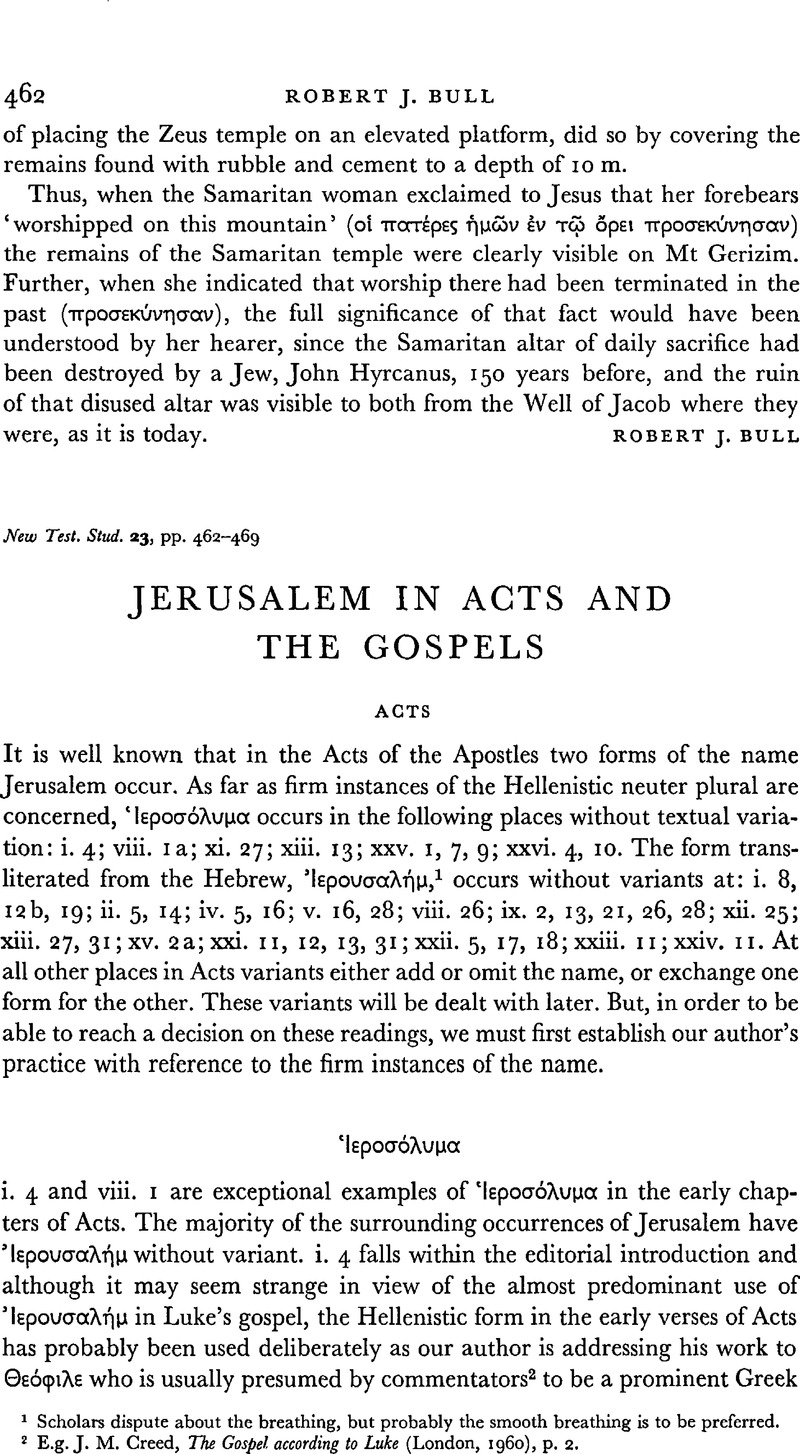Article contents
Jerusalem in Acts and the Gospels
Published online by Cambridge University Press: 05 February 2009
Abstract

- Type
- Short Studies
- Information
- Copyright
- Copyright © Cambridge University Press 1977
References
1 Scholars dispute about the breathing, but probably the smooth breathing is to be preferred.
2 E.g. Creed, J. M., The Gospel according to Luke (London, 1960), p. 2.Google Scholar
1 To borrow Schütz's term. See R. Schütz, Ίερουσαλημ und ![]() εροσολυμα im Neuen Testament’, ZNW xi (1910), 169–87.Google ScholarSchütz, and Harnack, A. (The Acts of the Apostles, E.T. London, 1909)Google Scholar and Bartlet, J. V. (‘The Twofold Use of “Jerusalem” in the Lukan Writings’, Exp. T. XIII (1901), pp.157–8)Google Scholar, do not deal with the textual variants and consequently find many exceptions to the rules they state as Luke's practice.
εροσολυμα im Neuen Testament’, ZNW xi (1910), 169–87.Google ScholarSchütz, and Harnack, A. (The Acts of the Apostles, E.T. London, 1909)Google Scholar and Bartlet, J. V. (‘The Twofold Use of “Jerusalem” in the Lukan Writings’, Exp. T. XIII (1901), pp.157–8)Google Scholar, do not deal with the textual variants and consequently find many exceptions to the rules they state as Luke's practice.
1 See Cadbury, H. J., The Making of Luke-Acts (London, 1927), p. 225.Google Scholar
2 Elsewhere, i.e. Rom. xv. 19, 25, 26, 31; I Cor. xvi. 3 (in all MSS except D), Paul uses Ίερουσαλήμ because the emphasis in these contexts is on Jerusalem as the holy city and the centre of the missionary activity.
3 Hanhart, R., Maccabaeorum liber 11 (Göttingen, 1959), p. 42.Google Scholar
1 The addition of Ίερουσαλήμ in variants at ii. 42, 43, viii. 1 b, xv. 2 wi11 be discussed below. If the longer texts arc accepted then the number will be increased.
1 At xxi. 13 the New English Bible avoids ‘in Jerusalem’ even though the Greek text on which it is based reads είς Ίερουσαλήμ!
2 E.g. Ropes, J. H., in vol. III of The Beginnings of Christianity, ed. by Jackson, F. J. Foes and Lake, K. (London, 1926)Google Scholar; Metzger, B. M., A Textual Commentary on the Greek New Testament (London, New York, 1971)Google Scholar, and Epp, E. J., The Theological Tendency of Codex Bezae Cantabrigensis in Acts (Cambridge, 1966).Google Scholar
1 See Epp, E. J., op. cit. p. 128.Google Scholar
2 Full discussion can be found in critical commentaries as well as in the works listed in note 2, p. 466.
3 Elsewhere Luke has Paul use Ίερουσαλήμ in such contexts, e.g. ix. 13; xiii. 27, 31; xxii. 5, 17, 18.
4 At xviii. 31; xix. 45; xx. I Luke omits mention of Jerusalem even though the parallels in Mark have Ίεροσόλυμα. By contrast, at v. 17; ix. 31; xxi. 20, 24, Luke has inserted Ίερουσαλήμ into the Markan material.
1 In view of the fact that Jeremias, J., ‘ΙΕΡΟΓΣАΛΗΜ/ΙΕΡΟΓΣΟΛΓΜА’ (sic), ZNW, LXV (1974), 273–6Google Scholar, ignores variants from his printed text, it is not surprising to note that he comments, p. 276, ‘Daβ Lukas trotzdem die profane Form in 1928 von Markus (111) übernahm, war offensichtlich ein Versehen’. Similarly, when discussing the We passages in Acts, Jeremias looks no further than the printed text and, seeing the use of Ίερουσαλήμ in xxi. 11, 12, 13, and Ίερόσολυμα in xxi. 4, 15, 17, can merely remark that the use of the name is ‘schwerlich rein zufällig’ (p. 276).
- 1
- Cited by


